Indian Society and Social Issues: May 2025 UPSC Current Affairs PDF Download
WHO Study on Adolescent Girls
Why in News?
Recently, a study conducted by the World Health Organization published in the Lancet medical journal highlighted alarming statistics regarding adolescent girls aged 15 to 19. The survey, which included thousands of respondents from 154 countries and regions, revealed that many of these girls have faced physical or sexual violence while in relationships.
Key Takeaways
- Approximately 24% of adolescent girls who have been in relationships experienced physical and/or sexual intimate partner violence by age 20.
- 16% of these girls reported experiencing such violence within the past year.
- No country is currently on track to meet the 2030 Sustainable Development Goal (Goal 5) of eliminating violence against women and girls.
Additional Details
- Prevalence Rates: The study found that the highest prevalence of intimate partner violence is in Oceania (47%), particularly in Papua New Guinea, where 49% of girls reported such violence. In contrast, central Europe and central Asia have the lowest rates (10% and 11%, respectively).
- Influencing Factors: Higher rates of violence are observed in lower-income countries, regions with fewer girls in secondary education, and places where girls have limited legal property rights. Child marriage significantly raises the risk of intimate partner violence due to power imbalances and economic dependency.
- According to the UN, 19% of young women worldwide were married in childhood in 2022.
The implications of intimate partner violence are severe, including increased risks of injuries, mental health issues like depression and anxiety, unplanned pregnancies, and sexually transmitted infections. These factors can lead to long-term physical and psychological consequences, affecting educational achievements and future prospects.
Steps Needed to Empower Adolescent Girls
- WHO Recommendations: Strengthening support services and early prevention measures targeted at adolescents.
- Implementing school-based programs to educate both boys and girls about healthy relationships and violence prevention.
- Providing legal protections and economic empowerment initiatives for women and girls.
- Ensuring gender-equal property rights and ending harmful practices such as child marriage.
- Supporting countries in measuring and addressing violence against women.
Other Steps Needed
- Access to Healthcare: Ensuring healthcare providers are trained to recognize and respond to signs of intimate partner violence, along with providing mental health services for affected girls.
- Challenging Gender Norms: Efforts should be made to shift societal attitudes that perpetuate gender inequality and violence against women and girls. Community awareness about the signs and consequences of intimate partner violence is essential.
- Continuous Monitoring: Regular surveys and studies are necessary to track the prevalence of intimate partner violence and the effectiveness of intervention programs, using data to inform policy development.
- Global Efforts: Collaboration with international organizations such as WHO is vital to share best practices and resources, and to create comprehensive national action plans addressing intimate partner violence across health, education, and legal sectors.
Addressing the challenges faced by adolescent girls requires a multifaceted approach that involves education, legal reforms, and community engagement to create a safer and more equitable environment for all.
The State of Food Security and Nutrition in the World 2024
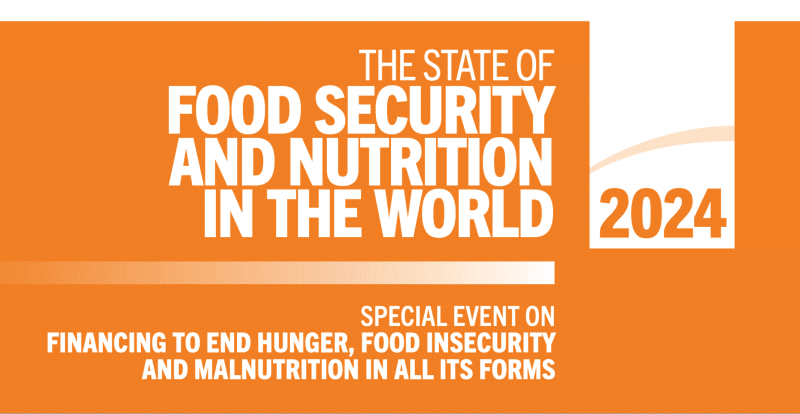
Why in News?
Recently, the 'State of Food Security and Nutrition in the World 2024' (SOFI 2024) report, published by FAO, IFAD, UNICEF, WFP, and WHO, presents a critical analysis of global food security and nutrition trends. This year's report emphasizes the urgent need for increased financing to end hunger, food insecurity, and malnutrition in all its forms.
Key Takeaways
- Between 713 and 757 million people faced hunger in 2023, with one out of eleven people globally and one out of every five in Africa experiencing hunger.
- Approximately 2.33 billion people experienced moderate or severe food insecurity in 2023, with over 864 million affected severely.
- The global average cost of a healthy diet rose to USD 3.96 per person per day in 2022, yet 2.83 billion people were unable to afford it.
- Improvements were seen in reducing stunting and wasting among children, but progress remains insufficient to meet 2030 SDG targets.
- Public spending on food security and nutrition is inadequate, particularly in low-income countries.
Additional Details
- Global Prevalence of Undernourishment: Asia has the largest number of undernourished people at 384.5 million, despite lower percentages compared to other regions.
- Food Insecurity: Severe food insecurity affected more than 864 million people globally, highlighting a significant challenge.
- Regional Disparities: The cost of a healthy diet varies, being highest in Latin America and the Caribbean and lowest in Oceania, with notable setbacks in Africa.
- Obesity and Anaemia: Rising obesity rates and increasing anaemia among women aged 15-49 pose significant public health challenges.
- Impact of COVID-19: The pandemic has exacerbated issues of food insecurity and malnutrition due to economic downturns and disruptions in food supply chains.
The SOFI 2024 report underscores the critical need for action to address food security and nutrition challenges worldwide, particularly in vulnerable regions and populations.
Key Highlights Related to India in the Report
- India has the highest number of undernourished individuals at 194.6 million, though this is a decrease from 240 million in 2004-06.
- Approximately 55.6% of the Indian population, or 790 million people, cannot afford a healthy diet.
- India ranked 111th in the Global Hunger Index (GHI) 2023, indicating significant food security issues.
- India has the highest prevalence of wasting (18.7%) and stunting (31.7%) in children under five in South Asia.
- Over 53% of women in India are anaemic, reflecting ongoing public health challenges.
Key Recommendations in the Report
- Increase Public Investment: Boost budgets for hunger and malnutrition programs involving local communities for better effectiveness.
- Mobilise Private Sector Investment: Encourage innovative financing mechanisms to support food security initiatives.
- Promote Climate-Resilient Agriculture: Implement agricultural practices that mitigate climate change impacts on food production.
- Focus on Vulnerable Populations: Support groups like small farmers, women, and children through nutrition programs.
- Strengthen Data Collection: Enhance data collection and integration for better tracking of food security and nutrition.
Persistent Issue of Violence Against Women in India
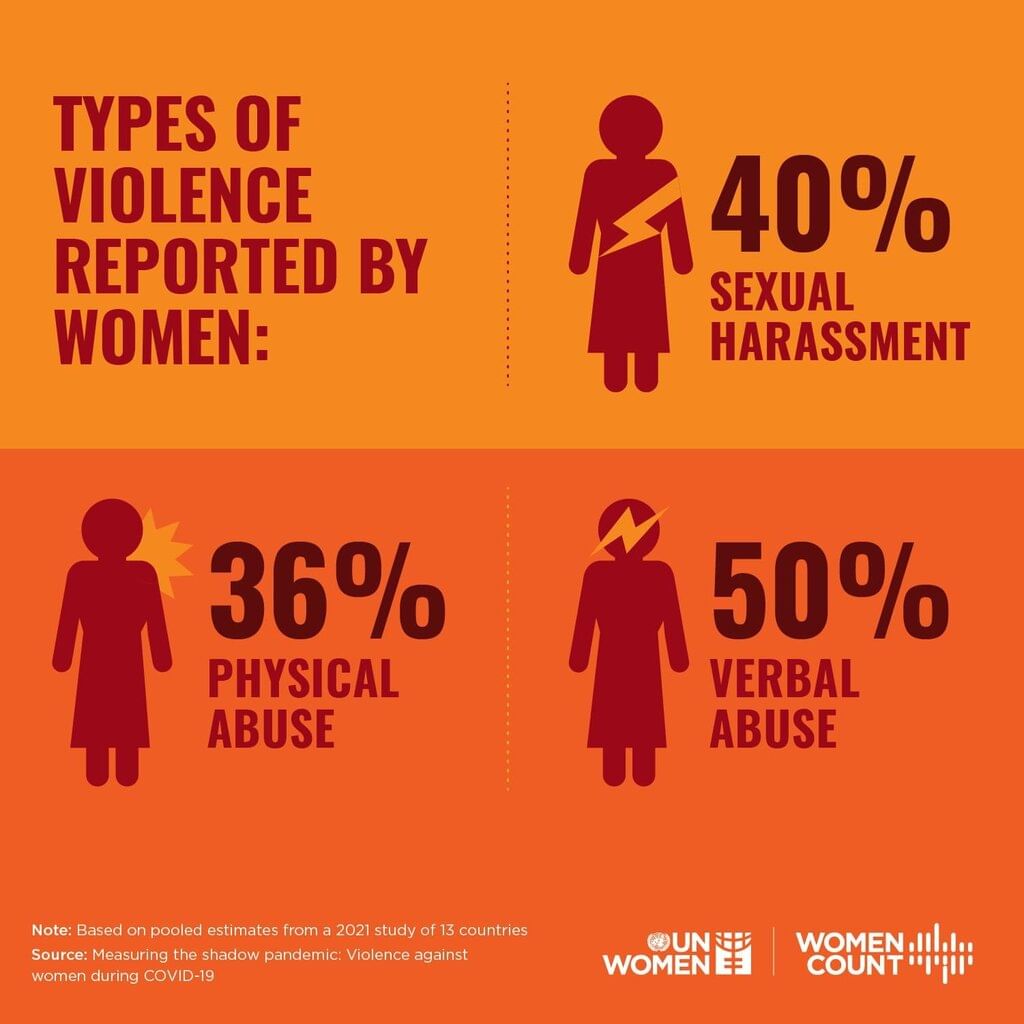 Why in News?
Why in News?
The recent rape and murder of a trainee doctor in Kolkata has reignited nationwide concerns about women's safety and intensified protests by healthcare workers, who are now calling for a Central law to protect them. Despite stricter laws, crimes against women persist and continue to rise, underscoring the urgent need for comprehensive reforms.
Key Takeaways
- The Indian Medical Association (IMA) is advocating for a Central Protection Act to ensure the safety of healthcare professionals.
- Healthcare workers demand enhanced safety measures in hospitals and medical facilities.
- Crime statistics reveal alarming trends in violence against women in India.
Additional Details
- Central Protection Act: The IMA seeks a nationwide law similar to the UK’s National Health Service (NHS) zero-tolerance policy, which effectively classifies assaults on healthcare workers as serious felonies. In the US, felonies are categorized into classes based on their maximum prison sentences, raising awareness about the severity of assaults.
- Current Provisions: Health and law enforcement are primarily State subjects, leading to inadequate data on attacks against medical professionals. The Ministry of Health and Family Welfare mandates filing a First Information Report (FIR) within six hours of any violence against healthcare workers.
- Crime Statistics: The National Crime Records Bureau (NCRB) reported 445,256 cases of crime against women in 2022. From 2018 to 2022, reported crimes against women rose by 12.9%, highlighting both increased incidents and improved reporting.
- Rising Crime Rates: The Women and Men in India 2023 report shows a rise from 359,849 cases in 2017 to over 445,000 in 2022, averaging 1,220 cases daily.
- Despite tough laws, conviction rates for rape have remained low, fluctuating between 27%-28% from 2018 to 2022.
The need for comprehensive reforms is evident as systemic issues, cultural norms, and legal challenges continue to undermine the effectiveness of existing laws. Advocacy for a Central Protection Act, enhanced monitoring of current laws, and public awareness campaigns are essential to address the persistent issue of violence against women in India.
Impact of Increased Mobility Among Rural Girls on Education
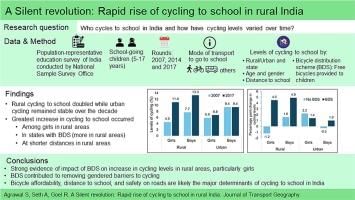 Why in News?
Why in News?
Recent research published in the Journal of Transport Geography highlights a significant increase in cycling levels among rural girls over the past decade. Researchers from the Indian Institute of Technology Delhi describe this trend as a 'silent revolution,' showcasing the effects of government interventions and evolving social norms on the mobility and education of rural girls.
Key Takeaways
- The percentage of girls cycling to school in rural areas more than doubled from 4.5% in 2007 to 11% in 2017.
- Nationally, cycling levels among children rose from 6.6% to 11.2%, with rural areas experiencing a twofold increase from 6.3% to 12.3%.
- Government Bicycle Distribution Schemes (BDS) have played a crucial role in promoting cycling among girls.
Additional Details
- Bicycle Distribution Schemes (BDS): These schemes, implemented in 20 out of 35 states and Union Territories, are designed to enhance cycling, particularly among school-going girls aged 14-17, to improve school enrollment and counteract higher dropout rates.
- In West Bengal, the BDS led to an increase in girls' cycling levels from 15.4% to 27.6%, while Bihar witnessed an eightfold increase.
- The increased access to education positively impacts long-term outcomes for girls, leading to better job prospects and economic independence, thereby fostering community growth.
- The rise in cycling among rural girls is a significant step toward challenging traditional patriarchal norms regarding women’s mobility, indicating a movement towards greater gender equality.
This growing trend of increased mobility among rural girls through cycling not only enhances educational opportunities but also empowers them socially and economically, contributing to broader social changes.
Mental Health Crisis Among Medical Students
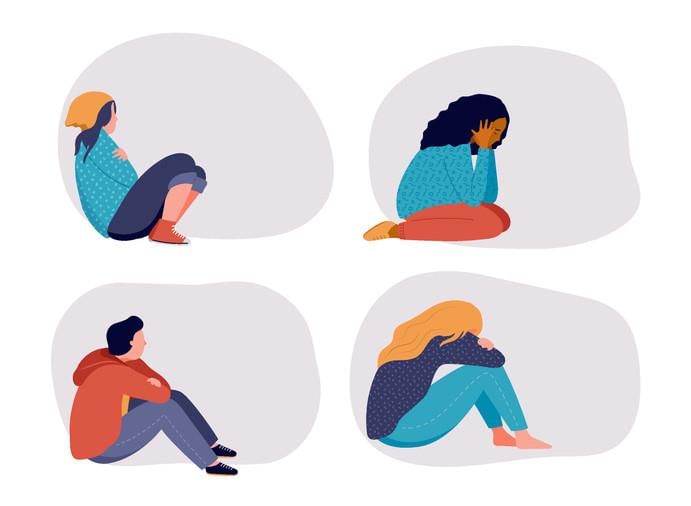 Why in News?
Why in News?
The recent report by the National Task Force on Mental Health and Well-being of Medical Students-2024, released by the National Medical Commission (NMC), highlights troubling statistics about the mental health of medical students in India.
Key Takeaways
- 84% of postgraduate (PG) medical students experience moderate to very high levels of stress.
- 27.8% of undergraduate medical students and 15.3% of postgraduate students have a diagnosed mental health disorder.
- 16.2% of undergraduate students and 31.2% of postgraduate students have had suicidal thoughts.
Additional Details
- Major Stressors: Medical students, especially postgraduates, face extended working hours, often exceeding 60 hours a week, leading to exhaustion and inadequate rest.
- Lack of Support: Insufficient mental health support systems within medical institutions leaves students without proper resources.
- 19% of PG students resort to substances such as tobacco and alcohol to cope with stress, indicating a need for education on healthier coping mechanisms.
- 33.9% of UG students face extreme financial stress, with many struggling to repay educational loans.
- Experiences of discrimination based on gender, caste, and other factors contribute to psychological distress.
Overall, the report reveals a significant mental health crisis among medical students, necessitating immediate attention and intervention.
Broader Mental Health Landscape in India
- According to the National Mental Health Survey (NMHS) 2015-16, 10.6% of adults in India suffer from mental health issues.
- The treatment gap for mental disorders ranges from 70% to 92% depending on the disorder.
- Urban areas show a higher prevalence of mental health issues (13.5%) compared to rural areas (6.9%).
- During the pandemic, 11% of students reported anxiety, and 14% experienced extreme emotions.
Policy Challenges in Addressing Mental Health
- Policy Neglect: Mental health is often a low priority for policymakers, hindered by a lack of political will.
- Budget Constraints: The mental health budget was only Rs 1,000 crore in 2023, far below the estimated need of over Rs 93,000 crore.
- Legislation Shortcomings: Despite the National Mental Health Policy of 2014 and the Mental Health Act of 2017, challenges in implementation remain.
- Human Resource Planning: There is a critical shortage of mental health professionals in India.
Initiatives Related to Mental Health in India
- National Mental Health Programme (NMHP)
- Mental Healthcare Act 2017
- National Institute of Mental Health and Neurosciences (NIMHANS)
- National Tele Mental Health Programme
- Ayushman Bharat – HWC Scheme
In conclusion, while various initiatives have been launched to improve mental health in India, significant challenges remain. Addressing these issues requires a comprehensive approach and strategic interventions to enhance mental health support and resources.
India’s First Comprehensive Cancer Multi-Omics Data Portal

Why in News?
Recently, the Indian Cancer Genome Atlas (ICGA) has introduced India’s inaugural comprehensive cancer multi-omics data portal. This platform serves as a repository specifically for cancer genomics data from Indian patients, providing open access to clinically correlated information.
Key Takeaways
- The portal aims to develop Indian-specific cancer datasets to facilitate personalized treatment protocols that consider the unique molecular characteristics of Indian populations.
- It begins with data from 50 breast cancer patients, with plans to expand to over 500 patients, and it will eventually include data from lung cancer and other types of cancer.
Additional Details
- Multi-Omics Data: The portal will feature genomic, transcriptomic, and proteomic data, including profiles of Deoxyribonucleic Acid (DNA), Ribonucleic Acid (RNA), and proteins integrated with clinical outcomes.
- cBioPortal Integration: Built on a globally recognized platform, it allows seamless integration with international cancer research, inviting contributions from researchers worldwide to enhance collaborative efforts.
- Free Access: The portal adheres to ethical data-sharing practices under Biotech-PRIDE (Promotion of Research and Innovation through Data Exchange) guidelines, fostering collaboration among the scientific community.
This initiative represents a significant step in addressing cancer treatment through tailored approaches that reflect the genetic diversity of Indian patients, ultimately aiming to improve cancer care across the country.
Disproportionate Burden on Working Women
Why in News?
The recent tragic death of a 26-year-old female Chartered Accountant at Ernst & Young (EY) has reignited discussions about the excessive workload and stress faced by young women professionals (white-collars) in India.
Key Takeaways
- Young professional Indian women work an average of 55 hours per week, significantly more than their counterparts in other countries.
- Only 8.5% of women hold professional scientific and technical jobs, indicating a severe gender imbalance.
- Women lead in unpaid domestic work, spending significantly more hours compared to men.
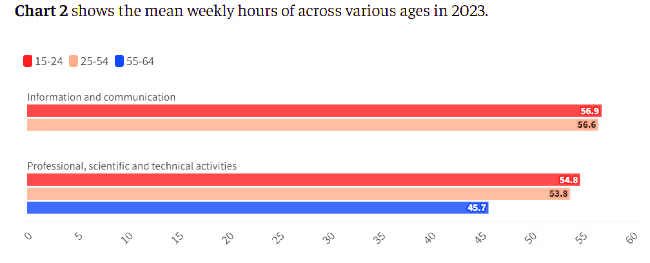
Additional Details
- Work Hours and Stress Levels: According to the International Labour Organisation (ILO) report, young women work between 9-11 hours daily, leaving only 7-10 hours for rest due to household responsibilities.
- Gender Imbalance in Professional Roles: India ranks 15th lowest among 145 countries in women's representation in professional scientific and technical roles.
- Unpaid Domestic Work: Women not in the labour force spent 7.5 hours daily on unpaid domestic work, while employed women spent an average of 5.8 hours.
- Regional Variations: Approximately 85% of women aged 15-59 engage in unpaid domestic work, with minimal differences between urban and rural areas.
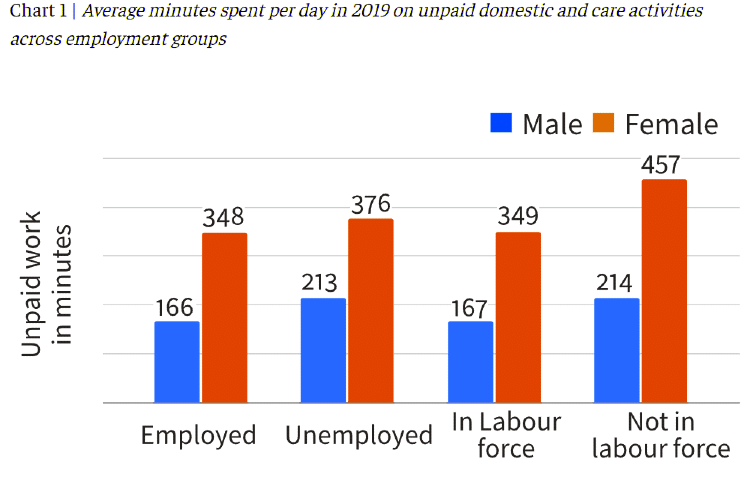 The white-collar job sector in India faces challenges including a lack of regulatory consistency and significant work-life balance issues, especially for women.
The white-collar job sector in India faces challenges including a lack of regulatory consistency and significant work-life balance issues, especially for women.
Current Situation of Regulation
- Legislative Framework: Current laws such as the Industrial Disputes Act, 1947, and the Shops and Establishments Act, 1954, govern employee rights but lack standardization across companies.
- Need for Regulation: A study in 2023 revealed that 42% of white-collar workers exceed the legal working limit of 48 hours per week.
- Impact of the Gig Economy: Many freelancers lack access to essential benefits like paid leave and health insurance, complicating their work conditions.
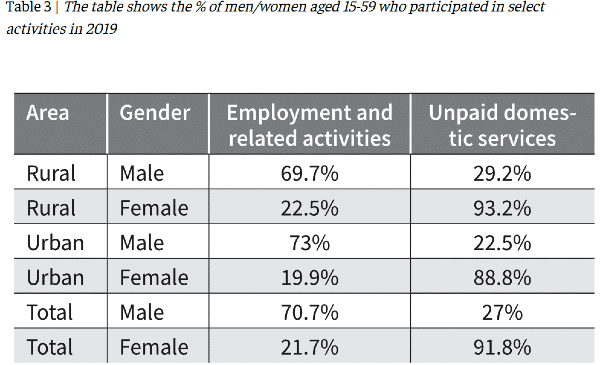
Addressing the challenges faced by women in the workforce is crucial for improving workplace conditions and ensuring gender equality in professional roles.
What Can be Done to Improve Working Conditions for Women in White-Collar Roles?
- Focus on Women’s Inclusion and Support: Implement policies ensuring gender equality, such as maternity leave and flexible working hours.
- Cultural Transformation: Promote employee well-being through initiatives that support mental health and discourage excessive work hours.
- Legal Reforms and Enforcement: Strengthen enforcement of existing labor laws and update regulations to address the needs of modern work environments.
- Government Policies and Awareness: Create policies that promote flexible work environments and raise awareness about employee rights.
By addressing these concerns, we can create a more equitable and supportive work environment for women in India.
SC Strengthening Law Against Child Pornography in India
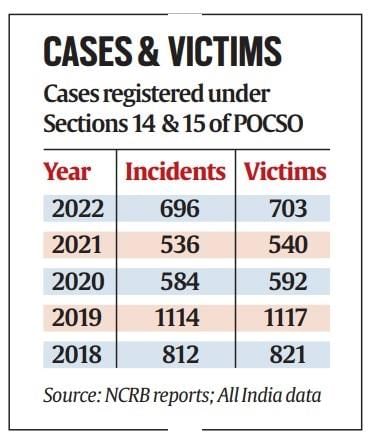 Why in News?
Why in News?
The Supreme Court of India has made a crucial advancement in the fight against child exploitation by reinforcing that the consumption of sexually explicit content involving minors is a serious criminal offence. This decision overturned a previous ruling by the Madras High Court, which had stated that passive consumption of child pornography did not constitute an offence under the Protection of Children from Sexual Offences (POCSO) Act or the Information Technology (IT) Act.
Key Takeaways
- The POCSO Act is India's first comprehensive law enacted in 2012 to combat sexual abuse against children.
- The Supreme Court has expanded the interpretation of the law to include passive consumption as an offence.
- Recommendations have been made to amend the POCSO Act to better reflect the nature of crimes against children.
Additional Details
- Protection of Children from Sexual Offences (POCSO) Act: This Act aims to protect children against sexual assault, harassment, and pornographic violations. It includes provisions for establishing special courts to expedite trials related to these offences.
- Concerns: There has been a rise in child abuse cases, particularly during the COVID-19 pandemic, indicating a growing need for awareness and legal action.
- SC’s Ruling on Section 15: The Supreme Court clarified that possession of child pornography is not limited to having physical copies; it can also include the potential to control or access such material.
- Recommendations: The SC urged the government to enhance victim support services and raise public awareness about child abuse and reporting mechanisms.
In summary, the Supreme Court's recent decision marks a significant step towards addressing child pornography in India, emphasizing the need for comprehensive legal frameworks and societal awareness to protect vulnerable children.
Recent Incident of Sexual Assault in India
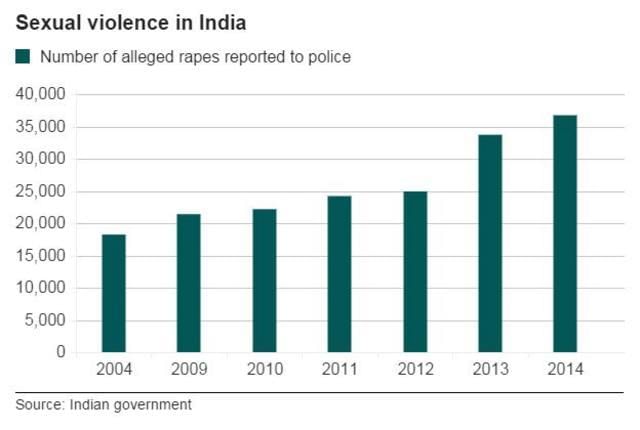 Why in News?
Why in News?
The recent incident of sexual assault and rape of a medical intern at RG Kar Medical Hospital in Kolkata has highlighted the ongoing issues of women's safety and the fight for gender justice in India.
Key Takeaways
- Definition of Rape: Non-consensual sexual penetration of any kind.
- Legal Framework: Defined under Section 375 of the Indian Penal Code, outlining circumstances under which rape is recognized.
- Prevalence: Significant rise in reported rape cases as per the National Crime Records Bureau (NCRB).
Additional Details
- Definition of Rape: Rape includes any non-consensual vaginal, anal, or oral penetration of a sexual nature. The legal definition specifies that consent obtained under coercion or fraud is not valid.
- Statistics: The NCRB reported 31,677 cases of rape in 2021, marking an increase from the previous year, with an average of 90 cases reported daily in 2022.
- Conviction Rates: Between 2018 and 2022, conviction rates for rape cases ranged from 27% to 28%.
- Impact of Rape: Rape is often used as a tool of violence against women, reflecting power dynamics and societal attitudes towards gender.
The societal implications of such incidents underline the need for comprehensive reforms in legal procedures and societal attitudes towards women. It is crucial to strengthen laws and promote gender justice to ensure safety and equality for all individuals.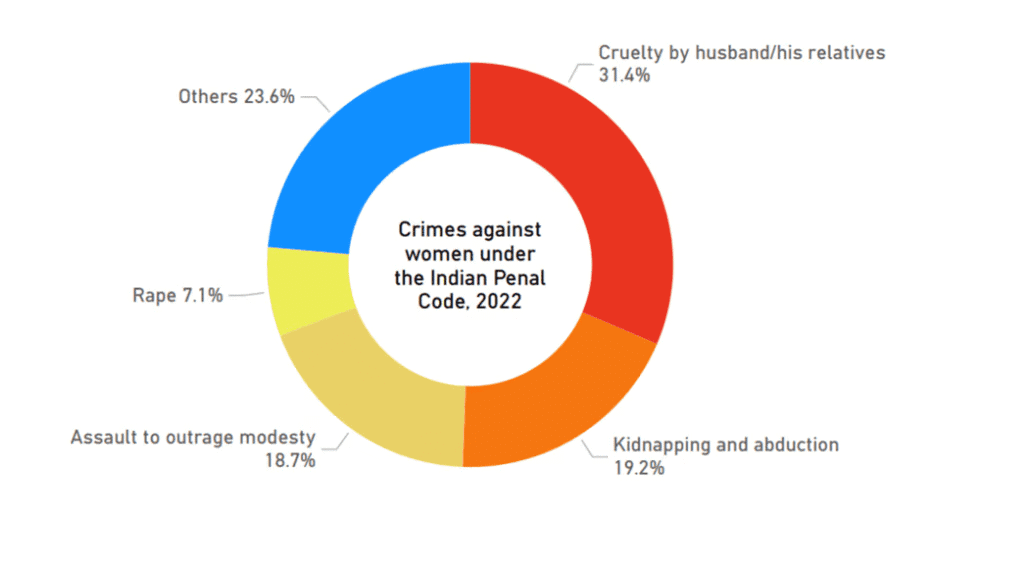
Who are Chenchus?
 Why in News?
Why in News?
The Chenchus, an indigenous tribe residing in the Nallamala forests of Andhra Pradesh, are facing increasing challenges due to modernization, which has led to reduced job opportunities under the Mahatma Gandhi National Rural Employment Guarantee Act (MGNREGA).
Key Takeaways
- The Chenchus are a Telugu-speaking food-gathering tribe living in the Nallamalai forests, recognized as a Scheduled Tribe in Andhra Pradesh.
- They maintain a conservative lifestyle, largely avoiding modern influences and continuing traditional practices.
- Their primary means of livelihood involves gathering food from the forest, such as roots, fruits, and other natural products.
Additional Details
- Chenchu Villages: Known as Penta, these villages consist of spaced huts grouped by kinship, where a village elder, or Peddamanishi, plays a crucial role in maintaining social order.
- The Chenchus practice a unique form of spirituality, worshipping various deities and integrating some Hindu religious practices. They have a historical association with the Srisailam temple, a significant pilgrimage site in their region.
- Despite their skills in food gathering, many Chenchus struggle economically and rely on selling their forest products to traders and cooperatives.
The Chenchus exemplify a lifestyle deeply connected to their forest environment, facing the challenge of adapting to a rapidly changing world while striving to preserve their cultural identity.
India’s Ageing Population
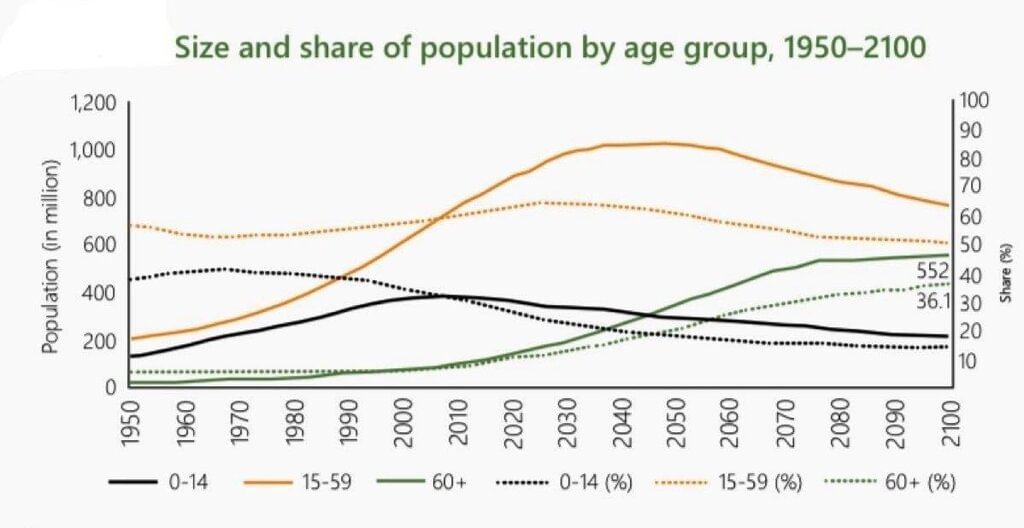 Why in News?
Why in News?
Recently, some politicians from India’s southern states have voiced concerns regarding the ageing and shrinking population, advocating for legislation to incentivize residents to have more children. The ageing population represents a significant demographic trend, characterized by an increasing proportion of individuals aged 65 and older in relation to the working-age population (15-64).
Key Takeaways
- India's population is projected to increase by 31.1 crore (311 million) from 2011 to 2036.
- Nearly half of this growth (17 crore) will occur in five states: Bihar, Uttar Pradesh, Maharashtra, West Bengal, and Madhya Pradesh.
- Uttar Pradesh will contribute 19% of the total population growth, whereas the five southern states will account for only 29 million.
Additional Details
- Ageing Population Trends: The number of individuals aged 60 years and older is expected to more than double from 10 crore (100 million) to 23 crore (230 million), increasing their share of the total population from 8.4% to 14.9%.
- The proportion of individuals aged 60 and older is projected to rise from 13% in 2011 to 23% by 2036, indicating that nearly 1 in 4 individuals will fall into this age group.
- The share of the 60+ population in the southern states is expected to increase from 7% in 2011 to 12% by 2036.
- There is a notable North-South divide, with northern states projected to see a smaller increase in the ageing population compared to southern states.
- For instance, Andhra Pradesh is expected to reach the Replacement Level of Fertility (2.1 children per woman) by 2025, significantly later than states like Kerala, which reached this level in 2004.
As India faces these demographic changes, it is essential to understand the implications and potential solutions to address the challenges posed by an ageing and shrinking population.
What are the Causes of Ageing and Shrinking Population?
- Contraception and Family Planning: Greater access to contraception and abortion services has empowered individuals to control their reproductive choices.
- Women's Economic Participation: Increasing participation of women in the workforce has led many to delay childbirth or opt out of having children for career and financial reasons.
- Improved Child Survival Rates: The under-five mortality rate has significantly declined, resulting in families choosing to have fewer children.
- Urbanization: Rising costs of living in urban areas often deter families from expanding their households.
- Migration: Indian migration to foreign countries, such as the UAE and USA, contributes to the decline in the domestic population.
What Concerns are Associated with the Ageing Population?
- Small Representation in Parliament: Southern states with ageing populations fear reduced political representation in the Lok Sabha.
- Slowing GDP Growth: An ageing population can lead to decreased economic growth due to a shrinking labor force.
- High Dependency Ratio: An increase in the proportion of dependents (both elderly and children) will burden the working-age population.
- Higher Public Expenditure: Costs for healthcare, pensions, and long-term care will rise significantly as the population ages.
- Intergenerational Equity Issues: Younger generations may feel unfairly taxed to support an older population.
- Pressure for Institutional Reform: The ageing population may lead to calls for reforms in retirement age and social security systems.
How do Countries Respond to Ageing Population?
- China’s Three-Child Policy: In 2021, China allowed families to have three children, changing the previous one-child policy.
- Japan's Parental Leave: Japan mandates twelve-month parental leave and provides financial aid to parents.
- Extended Retirement Age: Some countries have extended the retirement age to alleviate pension system pressures.
- Open Immigration Policy: Countries like Australia and Canada have adopted open immigration policies to counter labor shortages.
What can be done to Arrest Ageing and Shrinking Population?
- Pro-Natalist Policies: Scandinavian countries show that family support, childcare, gender equality, and parental leave can help maintain fertility rates.
- Leveraging Internal Migration: Encouraging migration from populous northern states to developed southern states can mitigate the ageing population's impact.
- Promoting Gender Equality: Initiatives that promote shared parenting responsibilities may lead to higher fertility rates.
In conclusion, addressing the challenges posed by an ageing and shrinking population in India requires a multifaceted approach, including policy reforms and initiatives to support family growth and economic stability.
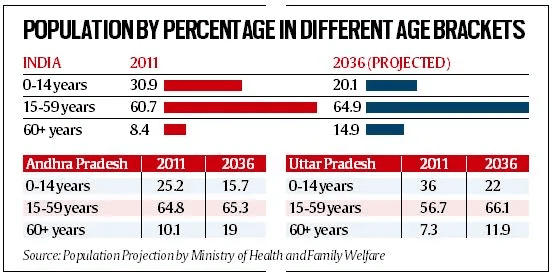
Global Hunger Index (GHI) 2024
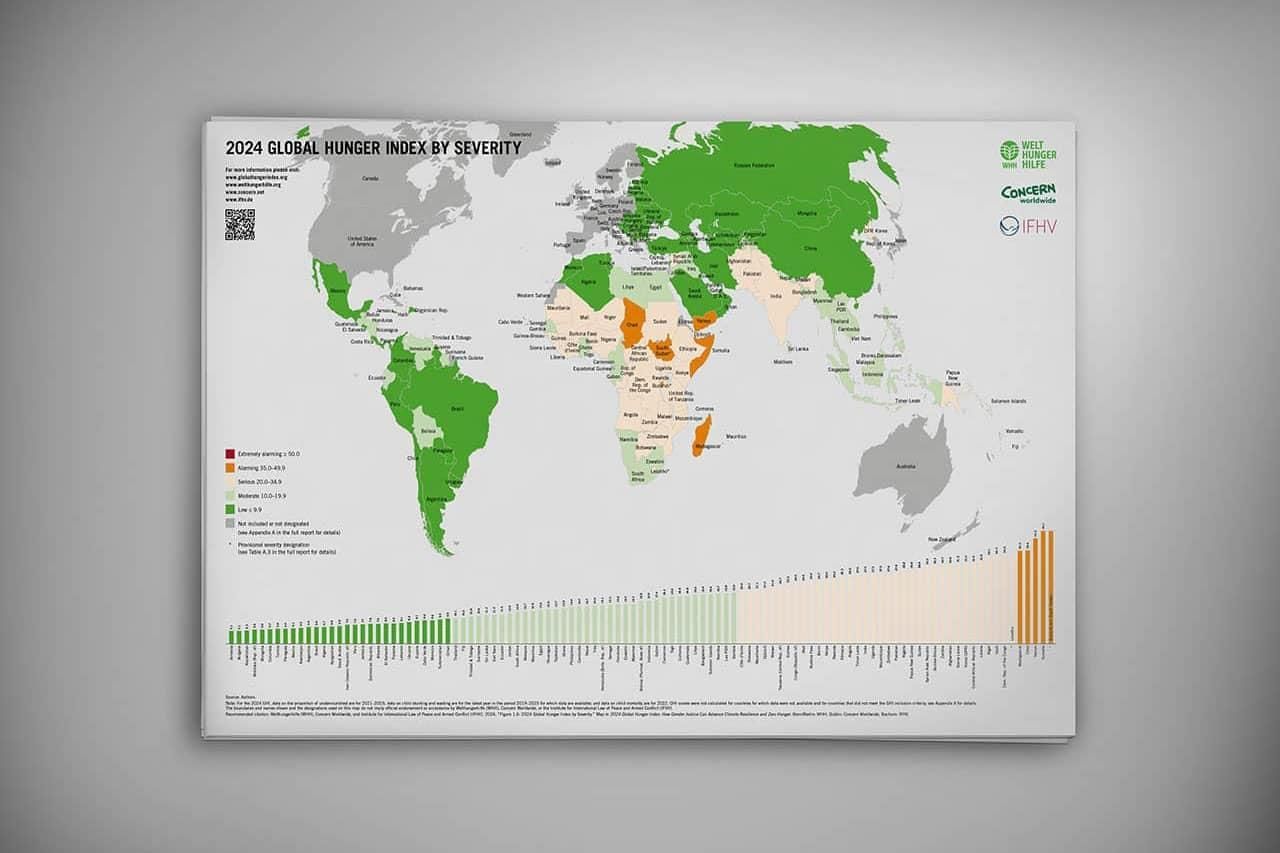 Why in News?
Why in News?
India's ranking in the 2024 Global Hunger Index (GHI) highlights the ongoing challenges it faces regarding hunger and malnutrition, standing at 105th out of 127 countries with a score of 27.3, which falls into the 'serious' range. Despite being one of the fastest-growing economies, India lags behind several South Asian neighbors, emphasizing the urgent need for effective interventions.
Key Takeaways
- India ranks 105th out of 127 countries in the GHI 2024.
- The GHI score for India is 27.3, indicating a serious level of hunger.
- There is a pressing need for coordinated efforts to tackle hunger and malnutrition.
Additional Details
- Global Hunger Index (GHI): The GHI is an annual publication that measures and tracks hunger globally, regionally, and nationally, reflecting multiple dimensions of hunger over time. It was created in 2006 and is now a joint project of Welthungerhilfe and Concern Worldwide.
- 2024 GHI Theme: 'How gender justice can advance climate resilience and zero hunger'.
- Current Global Hunger Statistics: The global GHI score is 18.3, showing slight improvement since 2016. Vulnerable populations include 2.8 billion people who cannot afford a healthy diet.
- Regional Disparities: Sub-Saharan Africa and South Asia face the highest rates of hunger and malnutrition, with ongoing conflicts exacerbating the situation.
- Underlying Causes of Hunger: Climate change, armed conflicts, and economic instability significantly impact food security.
- India Specific Findings: Approximately 35.5% of children under five in India are stunted, and 18.7% are wasted, indicating severe malnutrition issues.
The GHI 2024 serves as a stark reminder of the challenges India faces in eradicating hunger. It emphasizes the importance of comprehensive solutions that address the underlying causes of malnutrition, including enhanced food security, healthcare access, and targeted maternal and child nutrition programs. Initiatives like the National Food Security Act (NFSA) and PM POSHAN Scheme are critical in this fight against hunger.
Understanding MGNREGA and Worker Deletions
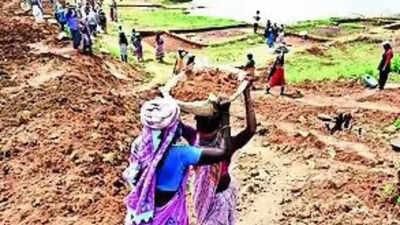 Why in News?
Why in News?
The past few years have witnessed a significant rise in the number of workers being removed from MGNREGA job cards, raising concerns about the impact on rural employment and livelihoods. The Mahatma Gandhi National Rural Employment Guarantee Act (MGNREGA) is a vital component of India's social security framework, guaranteeing 100 days of work annually for every rural household. However, recent trends show a troubling increase in the deletion of workers from job cards.
Key Takeaways
- MGNREGA provides a legal guarantee of work to rural households.
- Job cards are essential for implementing the provisions of MGNREGA.
- The recent spike in worker deletions undermines rural livelihoods.
Additional Details
- MGNREGA Job Cards: These are crucial documents issued to rural households under MGNREGA, ensuring access to employment. They include details about household members eligible for work and record wages earned.
- Unique Identification: Each job card is assigned a unique ID, ensuring that households can be tracked effectively.
- Challenges: There has been a concerning trend of arbitrary deletions linked to the implementation of Aadhaar-based payment systems, often without transparency or proper notice to the affected workers.
- Impact on Livelihoods: The deletion of workers from job cards can lead to loss of income and increased poverty, particularly affecting marginalized communities.
- Restoration Efforts: Recommendations to restore the right to work include strengthening accountability in the deletion process, independent audits of MGNREGA implementation, and raising public awareness about rights under the scheme.
The rising trend of worker deletions from MGNREGA job cards poses a serious threat to the rural employment landscape in India. It is crucial to address these issues to safeguard the entitlements of millions of rural households and ensure that they continue to receive the benefits of this important social security program.
Femicides in 2023: Global Estimates of Intimate Partner/Family Member Femicides Report
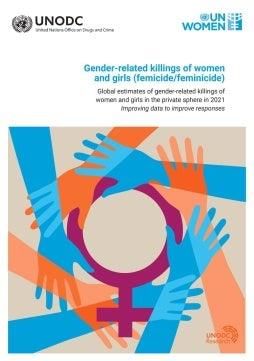 Why in News?
Why in News?
Recently, a significant report was released on the International Day for the Elimination of Violence against Women (25 November) by UN Women and the United Nations Office on Drugs and Crime (UNODC), highlighting the severity of the global crisis of femicide.
Key Takeaways
- In 2023, approximately 85,000 women and girls were intentionally killed globally, with 60% (around 51,100) killed by intimate partners or family members.
- On average, 140 women and girls per day became victims of femicide by intimate partners or close relatives.
Additional Details
- Global Scenario: Africa reported the highest number of victims (21,700) and the highest rate of femicide per population (2.9 per 100,000). The Americas and Oceania followed with rates of 1.6 and 1.5 per 100,000, while Asia and Europe reported significantly lower rates, at 0.8 and 0.6 per 100,000.
- Non-Domestic Femicide: Increasing recognition of non-domestic femicides includes cases from France (5% from 2019–2022) and South Africa (9% from 2020–2021).
- Male as Homicide Victims: An estimated 80% of all homicide victims in 2023 were men, while 20% were women. However, lethal violence disproportionately affects women, with nearly 60% of women intentionally killed being victims of intimate partner or family member homicide.
- Data availability has declined, with only half as many countries reporting in 2023 compared to 2020.
The report underscores the urgent need for a multifaceted approach to combat gender-based violence, emphasizing the importance of addressing its root causes, strengthening legal frameworks, increasing public awareness, and improving data collection.
Forms of Violence Against Women
- Domestic Violence: Actions by current or former partners or family members causing physical, sexual, or emotional harm, including physical aggression and psychological abuse.
- Sexual Violence: Unwanted sexual acts imposed without consent, targeting women and girls disproportionately, including rape and sexual harassment. In India, over 31,000 rape cases were reported in 2022, averaging 87 cases daily.
- Psychological Abuse: Intimidation through gestures or words, humiliation, and derogatory comments, as well as practices like isolating menstruating women and female infanticide.
- Cultural Abuse: Harmful social practices such as female genital mutilation, witch-branding, and child marriage.
- Technology-Facilitated Violence: Online harassment, stalking, and defamation, including distribution of morphed images and doxing.
Key Facts Regarding Gender Violence in India
- Increase in Crimes Against Women: According to the National Crime Records Bureau (NCRB) 2022 data, crimes against women rose 4% in 2022 compared to the previous year.
- Nature of Crimes Against Women: The majority of such crimes in 2022 were reported as follows:
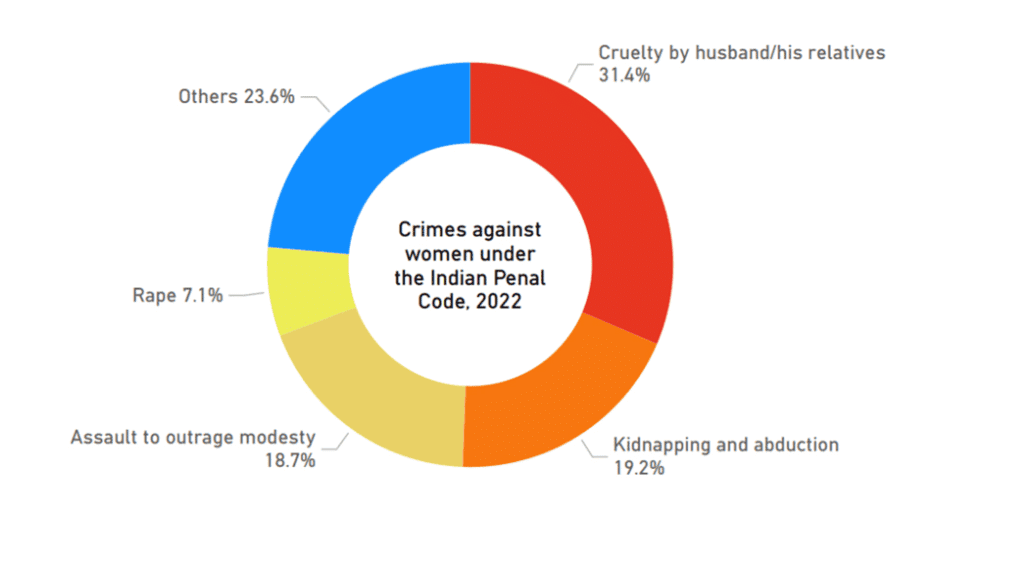
- Over 4.45 lakh cases of crimes against women were registered in 2022, equivalent to nearly 51 FIRs every hour.
- High Rape Cases: More than 31,000 rapes were reported in 2022, with a peak of nearly 39,000 in 2016.
Preventing Femicide
- Addressing Root Causes: Focus on individual attitudes and interpersonal relationships, while strengthening community and societal support systems.
- Educational Initiatives: Promote gender equality and relationship skills through educational curricula.
- Legal Measures: Classify femicide as a distinct criminal offense and establish specialized units for handling gender-based violence.
- Risk Reduction: Train police to identify high-risk situations and enforce protective measures for victims.
- Awareness Movements: Campaigns like #MeToo and Ni Una Menos aim to raise public awareness about gender-based violence.
In conclusion, the report calls for comprehensive action at multiple levels to effectively combat femicide and protect women's rights, emphasizing the importance of collaboration among individuals, communities, and institutions.
GQ-RCP Platform for HIV Detection
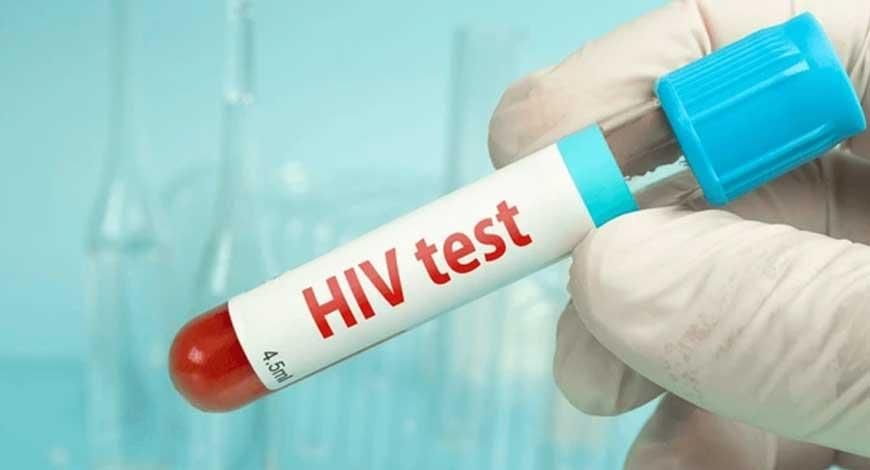 Why in News?
Why in News?
Recently, researchers at the Jawaharlal Nehru Centre for Advanced Scientific Research (JNCASR), an autonomous institute under the Department of Science and Technology, have developed a new technology for early and accurate detection of HIV. The GQ Topology-Targeted Reliable Conformational Polymorphism (GQ-RCP) platform, adapted from SARS-CoV-2 diagnostics, showcases the innovative capabilities of Indian research institutions.
Key Takeaways
- The GQ-RCP platform utilizes a unique G-Quadruplex (GQ) DNA structure for targeted detection of HIV.
- It enhances diagnostic reliability through a fluorometric test, significantly reducing false positives associated with HIV detection.
- The platform improves early detection capabilities, moving away from less specific general DNA sensing probes.
Additional Details
- G-Quadruplex (GQ) Structure: This four-stranded DNA conformation is crucial for various biological processes, including gene regulation and genome stability.
- The detection process involves reverse transcription amplification of a genomic segment, transitioning double-stranded DNA into its GQ conformation via a pH-mediated process.
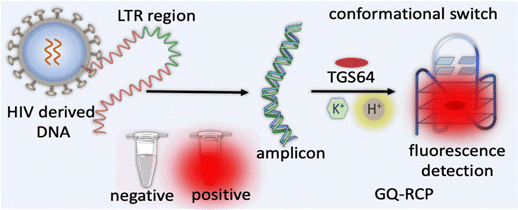
What is HIV?
About:
HIV stands for Human Immunodeficiency Virus, a virus that attacks the immune system in the human body. It primarily targets and damages CD4 immune cells, essential for fighting infections and diseases. Over time, HIV weakens the immune system, making the body vulnerable to opportunistic infections and cancers.
Transmission:
- HIV is primarily spread through the exchange of certain bodily fluids such as blood, semen, vaginal fluids, and breast milk.
Severity:
If left untreated, the virus can lead to Acquired Immunodeficiency Syndrome (AIDS), resulting in life-threatening opportunistic infections.
Cure:
While there is currently no cure for HIV, the disease can be managed effectively using antiretroviral therapy, which suppresses the virus's replication and allows CD4 immune cell counts to recover.
What is the State of HIV Infection in India?
Current Prevalence:
According to the National AIDS Control Organization (NACO), as of 2021, approximately 2.4 million people are living with HIV in India, with an adult prevalence rate of 0.22%. The India HIV Estimates 2021 report indicated a downward trend in new infections.
Demographic Distribution:
- The epidemic is concentrated among high-risk populations, including female sex workers (2.61%) and injecting drug users (5.91%).
- Children under 15 years account for about 3.5% of all infections, while women represent approximately 39% of the total HIV-positive population.
High-Prevalence States:
- The northeast region states have the highest adult HIV prevalence, with 2.70% in Mizoram, 1.36% in Nagaland, and 1.05% in Manipur.
- Southern states such as Andhra Pradesh (0.67%), Telangana (0.47%), and Karnataka (0.46%) also show significant prevalence.
- The largest number of People Living with HIV (PLHIV) is in southern states, with Maharashtra, Andhra Pradesh, and Karnataka being the top three.
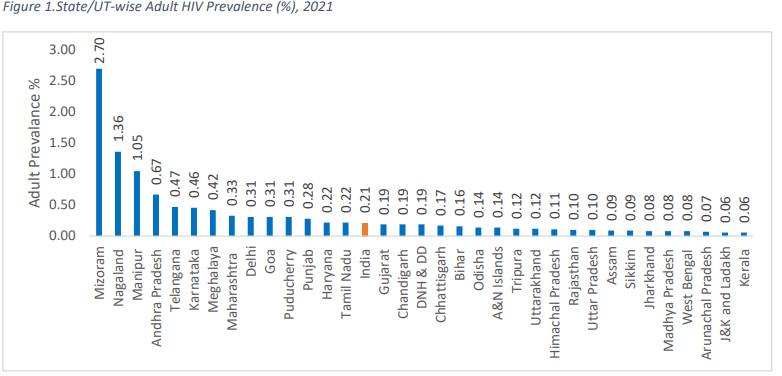
What are the Government Initiatives Related to HIV?
National AIDS Control Program (NACP):
Established shortly after the first AIDS case was reported in India in 1986, the NACP has evolved through multiple phases since its inception in 1992, focusing on prevention, treatment, and care for individuals living with HIV/AIDS.
Phases of NACP:
- Phase I (1992-1999): Focused on awareness generation, blood safety, and establishing surveillance systems.
- Phase II (1999-2006): Expanded targeted interventions for high-risk populations and involved NGOs in implementation.
- Phase III (2007-2012): Scaled up targeted interventions and strengthened surveillance, emphasizing partnerships with civil society organizations.
- Phase IV (2012-2021): Aimed to consolidate gains and integrate HIV services into the public health system, focusing on comprehensive care and support.
- Phase V (2021-2026): Aims to reduce new HIV infections and AIDS-related deaths by 80% by 2025-26 compared to 2010 levels.
Legislative Framework:
The HIV/AIDS Prevention and Control Act (2017) provides a legal framework to protect the rights of people living with HIV/AIDS, ensuring access to treatment without stigma or discrimination.
International Support:
India receives technical assistance and funding from various international partners such as UNAIDS, WHO, the World Bank, and private foundations like the Bill & Melinda Gates Foundation.
Impact of Covid-19 Pandemic
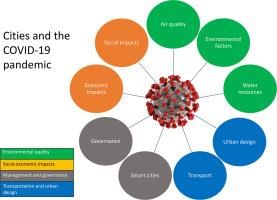 Why in News?
Why in News?
Recently, the world marked five years since the outbreak of the Covid-19 pandemic, which resulted in millions of deaths, unprecedented economic disruptions, and significant social challenges. Although much of the immediate crisis has passed, its lingering effects on global economies, policies, and societies continue to shape the world profoundly.
Key Takeaways
- The pandemic caused a sharp contraction in global GDP and significant shifts in economic policies.
- India's GDP growth rate dropped to -5.8% during 2020-21 but showed robust recovery afterward.
- Public debt surged globally, constraining fiscal flexibility.
- The pandemic led to an erosion of public trust in institutions and a rise in alternative work models.
Additional Details
- Economic Impact:
- India experienced a GDP contraction of -5.8% due to stringent lockdowns, compared to the pre-Covid average of 6.6%.
- Post-pandemic recovery saw growth rates of 9.7%, 7%, and 8.2% in the years 2021 to 2023.
- Global GDP contracted by 3.1% in 2020, with a reported shortfall of nearly USD 4.7 trillion from the original forecasts.
- Debt Explosion: Governments worldwide borrowed heavily during the pandemic, leading to the largest increase in public debt in two decades. This high debt level limits fiscal flexibility and affects sectors like health and education.
- Industrial Policies: The pandemic revealed vulnerabilities in global supply chains, prompting governments to introduce new policies aimed at enhancing self-sufficiency, such as the US CHIPS Act and India's Production-Linked Incentives.
- Social Dynamics: The Edelman Trust Barometer indicated a sharp decline in public trust in institutions post-pandemic, with a significant portion of the population feeling disconnected from elected officials.
- Changing Work Models: The pandemic popularized hybrid work, with 42% of Indian job seekers in 2024 prioritizing flexible hours and the rise of gig work enabling alternative income streams.
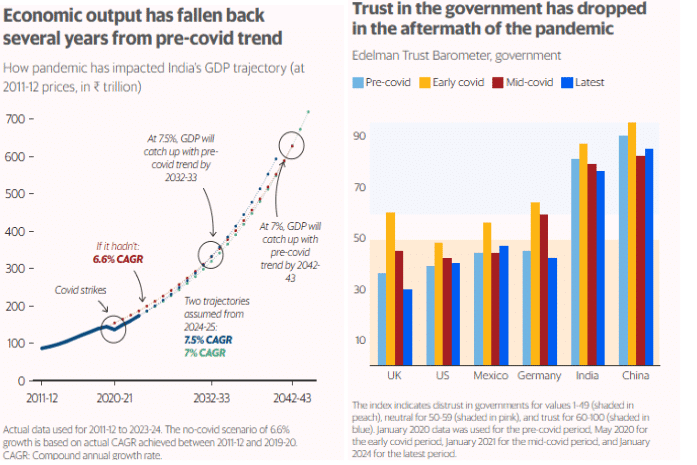
In conclusion, the Covid-19 pandemic has drastically altered economic trajectories, social trust, and work models. Moving forward, it is crucial to adopt strategies that foster economic recovery, enhance supply chain resilience, and improve public trust in governance.
Rising Drug Abuse Among Youth
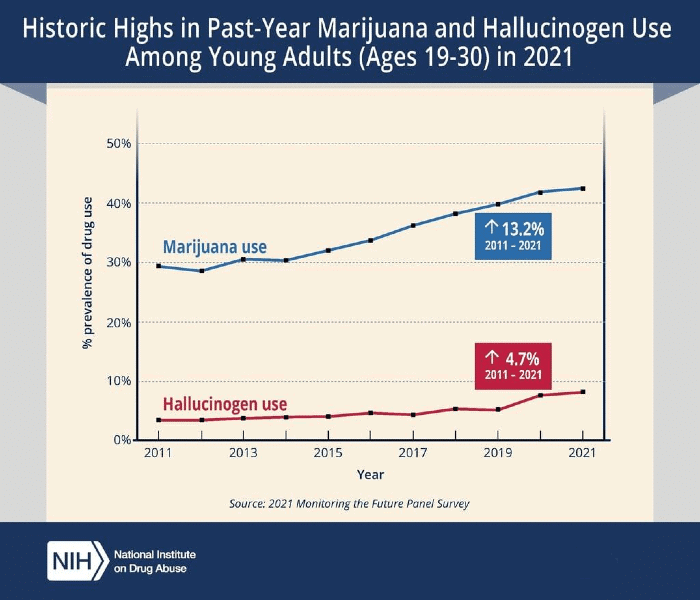
Why in News?
The Supreme Court of India has raised alarms over the increasing drug abuse among youth, labeling it a generational threat. This concern arose during a ruling that supported the National Investigation Agency's (NIA) investigation into a heroin smuggling case linked to Pakistan. The court called for immediate collective action from families, society, and government bodies to combat the escalating issue of drug abuse.
Key Takeaways
- The Supreme Court views rising drug abuse as a significant threat to the youth.
- Urgent action is needed from all sectors to address this growing problem.
Additional Details
- Global Drug Use: According to the World Drug Report 2024 by the United Nations Office on Drugs and Crime (UNODC), global drug use has reached 292 million people, representing a 20% increase over the last decade.
- Drug Preferences:The most commonly used drugs include:
- Cannabis: 228 million users
- Opioids: 60 million users
- Amphetamines: 30 million users
- Cocaine: 23 million users
- Ecstasy: 20 million users
- Emerging Threats: New synthetic opioids, particularly netizens, are becoming more potent than fentanyl and are a growing cause of overdose deaths, especially in wealthier nations.
- Treatment Gap: Only 1 in 11 individuals with drug use disorders, amounting to 64 million people, receive treatment; this rate is even lower for women.
Drug Prevalence in India
- Approximately 100 million people in India are affected by various narcotics.
- States like Uttar Pradesh, Maharashtra, and Punjab have reported the highest number of FIRs under the Narcotic Drugs and Psychotropic Substances Act (NDPS) from 2019 to 2021.
- Alcohol Use: About 16 crore individuals (14.6%) between the ages of 10 and 75 are current alcohol users; 5.2% are alcohol dependent.
- Cannabis Users: 3.1 crore people (2.8%) utilize cannabis, with 72 lakh (0.66%) facing cannabis-related issues.
- Opioid Use: 2.06% of the population uses opioids, with nearly 0.55% (60 lakh) requiring treatment.
- Sedative Abuse: 1.18 crore (1.08%) individuals use sedatives non-medically.
- Inhalant Abuse: 1.7% of children and adolescents abuse inhalants, a rate significantly higher than the 0.58% prevalence in adults.
- Injecting Drug Use: Approximately 8.5 lakh people in India are known to inject drugs.
Factors Contributing to Drug Abuse in India
- Peer Influence: Social dynamics encourage experimentation among youth, particularly in educational settings.
- Academic Stress and Mental Health Issues: High academic pressures lead some youth to use drugs as coping mechanisms.
- Cultural Norms and Media Influence: The glamorization of drug use in media fosters acceptance among young people.
- Socio-Economic Factors: Poverty and lack of resources contribute to higher rates of substance abuse as a form of escape.
- Family Environment: Dysfunctional family dynamics and parental substance abuse correlate with increased youth drug use.
- Legal System Loopholes: Organized crime syndicates exploit weaknesses in legal frameworks, facilitating drug trafficking.
- Easy Availability: The widespread availability of drugs, particularly in Punjab, has led to high rates of abuse.
- Fear of Strict Laws: Strict regulations can deter families from seeking help for drug-related issues.
Government Measures to Tackle Drug Abuse in India
- Legislative Measures:
- The Narcotic Drugs and Psychotropic Substances (NDPS) Act, 1985, regulates narcotics.
- The Drugs and Cosmetics Act, 1940, and the Prevention of Illicit Traffic in Narcotic Drugs and Psychotropic Substances (PITNDPS) Act, 1988, provide a legal framework for controlling drug trafficking.
- Institutional Measures:
- The Central Counter Terrorism Law Enforcement Agency tackles drug trafficking linked to national security.
- The National Narcotics Control Bureau (NCB) coordinates drug law enforcement efforts.
- Preventive and Rehabilitation Measures:
- The National Action Plan for Drug Demand Reduction (NAPDDR) aims to reduce drug demand through awareness and rehabilitation.
- Initiatives like Nasha Mukt Bharat Abhiyan focus on educating school children about the dangers of drugs.
To effectively combat drug abuse, India must strengthen existing laws and adopt a comprehensive national policy that emphasizes prevention, rehabilitation, and stringent enforcement. Multi-sectoral collaboration and community engagement are essential for creating a sustainable solution to this pressing issue.
Misuse of Indian Law
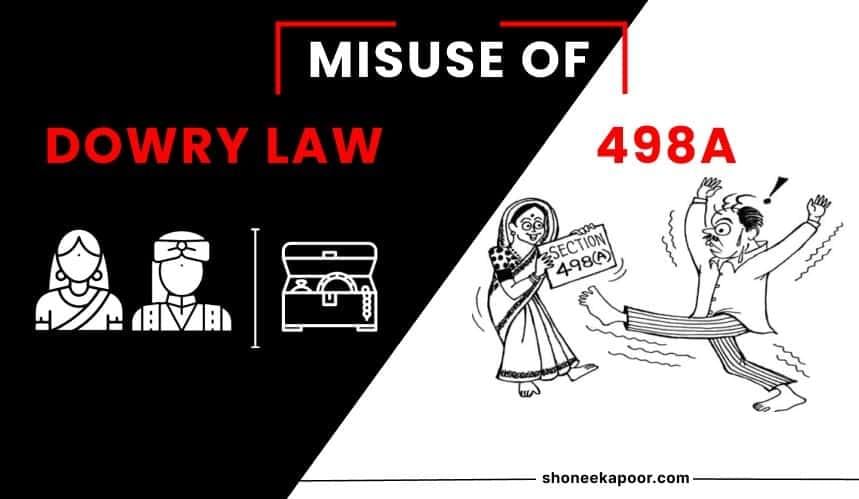 Why in News?
Why in News?
Recently, a Public Interest Litigation (PIL) was filed in the Supreme Court (SC) following the suicide of a techie in Bengaluru. The petition seeks intervention to review and reform dowry and domestic violence laws, claiming that these laws have been misused to settle unrelated disputes and to suppress the husband's family.
Key Takeaways
- The Dowry Prohibition Act, 1961 and Section 498A of the Indian Penal Code (now Bharatiya Nyaya Sanhita) are alleged to be misused.
- Legal provisions like Section 304B (Dowry Death) and Section 498A may lead to wrongful imprisonment based on unproven allegations.
- Men often face stigma and lack legal protections in cases of domestic violence and false accusations.
Additional Details
- Section 304B (Dowry Death): This section presumes that any unnatural death of a married woman is due to dowry demands, leading to severe penalties for husbands or relatives.
- Section 498A (Cruelty Against Women): This provision allows for up to three years of imprisonment and is non-bailable. It presumes guilt, making it easy for false accusations to arise.
- Section 375 (Rape): Only men are recognized as perpetrators, excluding male and transgender victims from legal protection.
- Section 354 (Assault to Outrage Modesty): This law protects women's modesty but lacks similar protections for men and transgender individuals.
- Maintenance Laws: Section 125 of the CrPC mandates that men provide financial support to their wives, parents, and children, often disregarding women's actual financial needs.
- Protection of Women from Domestic Violence Act, 2005: This act does not provide protections for men facing abuse from partners.
- Custody and Divorce Proceedings: Courts tend to favor mothers in custody cases, often marginalizing fathers despite their close relationships with children.
The impacts of false accusations can lead to significant psychological distress, social stigma, suppressed emotions, and increased rates of marital suicide among men. Financial burdens from legal fees and potential job losses further exacerbate these issues.
Judicial Stand on Indian Law
- Sakshi v Union of India (1999): The Supreme Court called for gender-neutral rape laws, leading to recommendations for replacing the term 'rape' with 'sexual assault.'
- Priya Patel v State of MP (2006): The court ruled that a woman could not be convicted of rape even if she actively participated in the crime.
- Sushil Kumar Sharma Case (2005): The Supreme Court acknowledged the potential for legal terrorism under Section 498A but upheld its constitutionality.
- Chandrabhan Case (1954): The Delhi HC noted that many complaints arise from trivial disputes and often harm children caught in those conflicts.
- Arnesh Kumar v State of Bihar (2014): The SC stressed caution in arrests under Section 498A due to its serious implications.
How to Achieve Gender-Neutrality in Indian Laws?
- Acknowledging Gender Bias: Recognizing that men can also be victims of domestic violence and harassment is crucial for legal reform.
- Sensitizing the Criminal Justice System: Training for judges and police on gender biases is necessary to promote fairness in legal proceedings.
- Revising Existing Laws: Adopting gender-neutral language ensures equal protection under the law for all genders.
- Institutions for Men’s Welfare: Establishing gender-neutral institutions can promote equal rights for all individuals.
- Sensitizing Society: Challenging stereotypes that dictate gender roles is essential for achieving true equality.
In conclusion, addressing the biases in Indian laws and implementing gender-neutral reforms are crucial steps towards achieving equality and justice for all individuals, regardless of gender.














